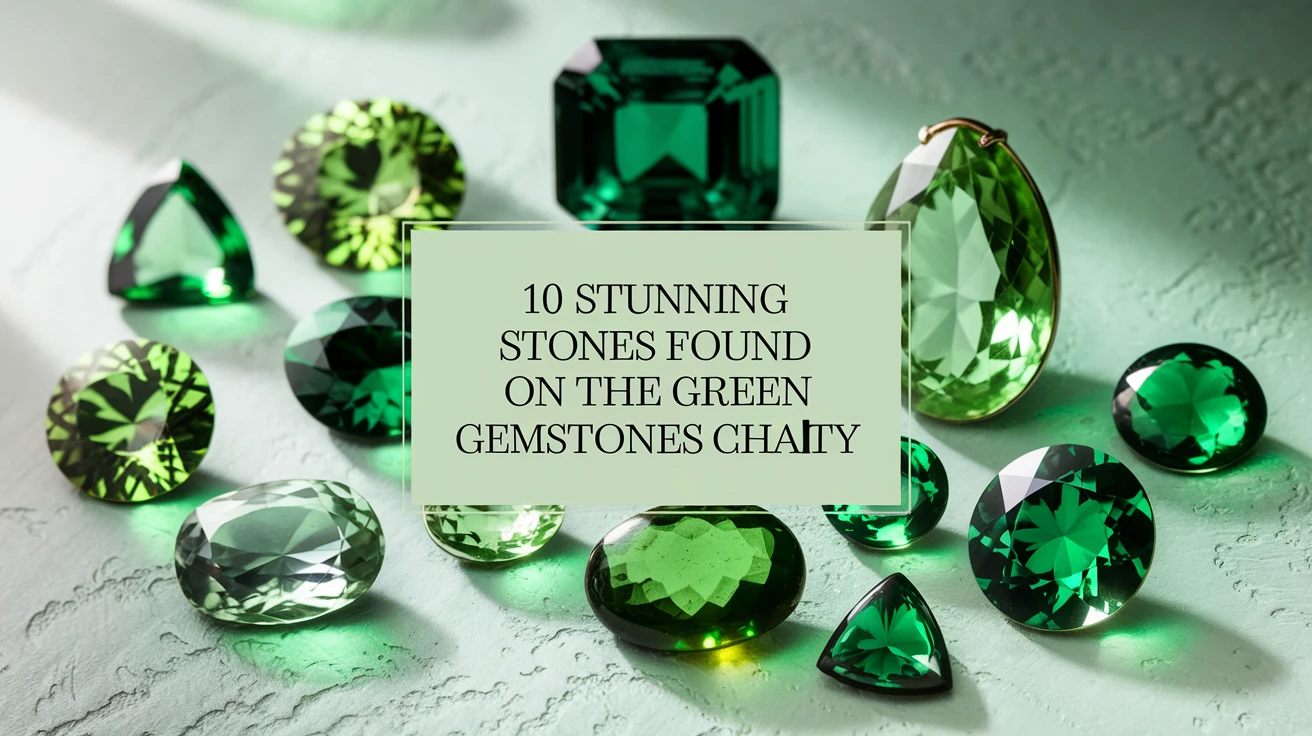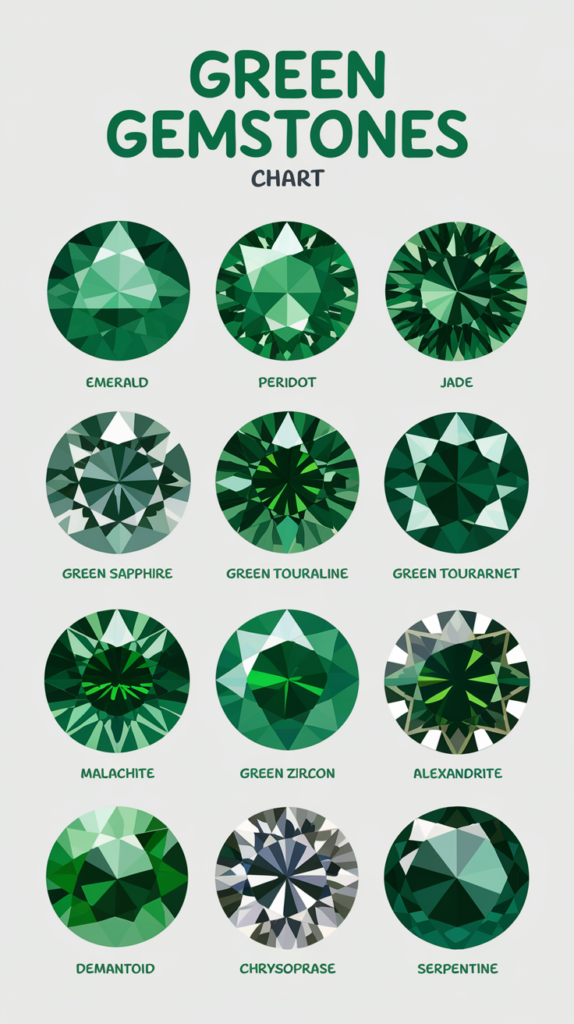
The world of green gemstones has always captivated my attention, especially after stumbling upon a remarkable peridot during a trip to Arizona. That discovery sparked my passion for collecting and studying these verdant treasures. Today, I’m excited to share insights about the most stunning stones you’ll find on the green gemstones chart, along with practical knowledge I’ve gathered over years of collecting and trading.
Understanding Green Gemstones: Nature’s Verdant Treasures
Green gemstones hold a special place in the jewelry world, symbolizing growth, harmony, and natural beauty. Their formation process spans millions of years, creating unique pieces that range from transparent to opaque, pale sage to deep forest green.
| Color Range | Common Formations | Typical Locations |
|---|---|---|
| Pale Green | Crystalline | Brazil, Colombia |
| Medium Green | Massive | Africa, Asia |
| Dark Green | Mixed | Australia, Russia |
1. Emerald: The Crown Jewel of Green Gemstones
Nothing quite matches the allure of a fine emerald. I remember my first encounter with a Colombian emerald – its deep, mysterious green color literally took my breath away. These precious stones command high prices for good reason.
Key Characteristics of Emeralds:
- Hardness: 7.5-8 on the Mohs scale
- Origin: Primarily Colombia, Zambia, and Brazil
- Color range: Deep green to slightly bluish-green
- Common inclusions: Garden-like patterns called jardin
2. Peridot: The Evening Emerald
Often mistaken for emeralds in ancient times, peridot has its own unique charm. During a desert expedition, I discovered how these gems can literally sparkle under the moonlight – hence their nickname “evening emeralds.”
Notable Peridot Features:
- Hardness: 6.5-7 on the Mohs scale
- Origin: Egypt, Arizona, China
- Distinctive yellow-green color
- Often found in volcanic areas
3. Green Tourmaline: The Rainbow Stone
Tourmaline’s versatility never ceases to amaze me. Each piece tells its own story through subtle color variations and pleochroic properties.
| Variety | Color Description | Value Range |
|---|---|---|
| Chrome Tourmaline | Emerald-like green | High |
| Mint Tourmaline | Pale, fresh green | Medium |
| Watermelon Tourmaline | Green exterior, pink interior | Very High |
4. Jade: The Stone of Heaven
My journey into jade began during a trip to Asia, where I learned about its deep cultural significance and incredible toughness. Both jadeite and nephrite varieties offer unique beauty.
Types of Jade:
- Jadeite: Higher value, more vibrant colors
- Nephrite: More common, excellent durability
- Imperial Jade: Most valuable, vivid green
5. Green Garnet: The Underrated Beauty
Tsavorite and demantoid garnets deserve more recognition. Their brilliance often surpasses that of emeralds, yet they’re frequently overlooked by collectors.
6. Malachite: Nature’s Art
The banded patterns in malachite never fail to mesmerize. Each piece resembles a miniature abstract painting created by nature itself.
7. Green Sapphire: The Rare Alternative
While blue sapphires get all the attention, green sapphires offer unique beauty and excellent durability. They’re perfect for everyday wear.
8. Chrysoprase: The Apple Stone
This chalcedony variety carries a fresh, spring-like green that always brings a smile to my face. It’s becoming increasingly popular in modern jewelry designs.
9. Green Aventurine: The Lucky Stone
Known for bringing good fortune, aventurine’s subtle sparkle comes from tiny inclusions that create a phenomenon called aventurescence.
10. Green Apatite: The Deceptive Beauty
Often confused with more expensive stones, apatite’s beauty stands on its own merit. Its color range is simply spectacular.
Care and Maintenance Tips
- Store stones separately to prevent scratching
- Clean with mild soap and warm water
- Avoid ultrasonic cleaners for included stones
- Keep away from harsh chemicals
Frequently Asked Questions
Q1: Which green gemstone is the most valuable?
Fine quality emeralds typically command the highest prices among green gemstones, particularly those from Colombia.
Q2: Are green diamonds real?
Yes, natural green diamonds exist but are extremely rare. Their color comes from natural radiation exposure.
Q3: What causes the green color in gemstones?
The green color typically comes from chromium, iron, or vanadium elements present during formation.
Q4: Which green gemstone is most durable?
Green sapphire ranks highest in durability among green gemstones, with a Mohs hardness of 9.
Q5: How can I tell if a green gemstone is real?
Professional certification, specific gravity tests, and examination under magnification are reliable methods.
Q6: What’s the most affordable green gemstone?
Green aventurine and some varieties of green quartz are typically the most budget-friendly options.
Q7: Can green gemstones fade in sunlight?
Some can, particularly kunzite and certain prasiolites. Always ask about specific care requirements.
Q8: What’s the difference between natural and synthetic green gemstones?
Natural stones form in nature over millions of years, while synthetic stones are lab-created but share identical chemical properties.
Q9: How should I clean my green gemstones?
Warm water with mild soap is safest. Avoid harsh chemicals and ultrasonic cleaners for softer or included stones.
Q10: Which green gemstone is best for everyday wear?
Green sapphire and tourmaline are excellent choices due to their durability and resistance to scratching.
Key Takeaways
- Each green gemstone has unique properties and care requirements
- Quality factors include color intensity, clarity, and cut
- Proper care ensures longevity of your stones
- Certificate of authenticity is crucial for valuable pieces
Whether you’re a seasoned collector or just starting your journey into the world of green gemstones, remember that each stone tells its own story. Take time to learn about their unique characteristics, and you’ll develop a deeper appreciation for these natural wonders.

